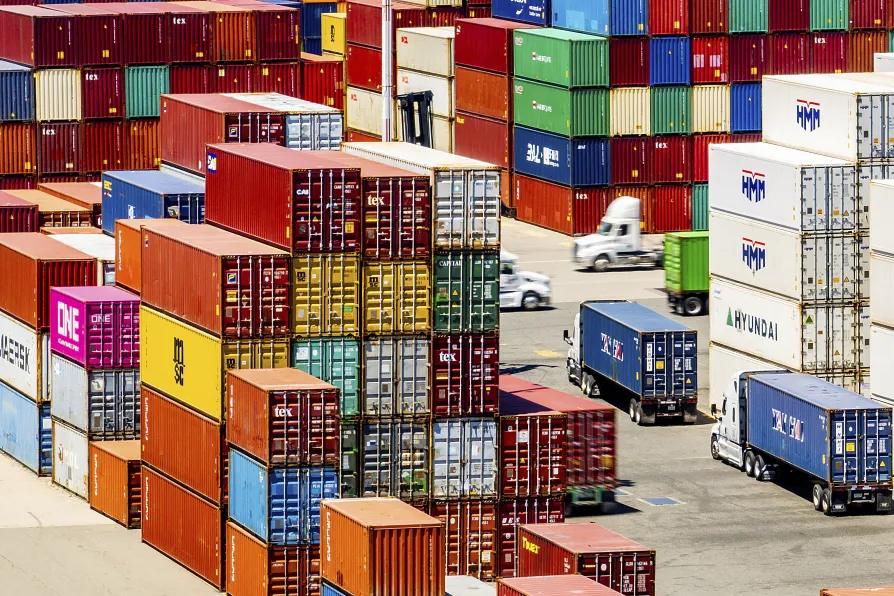Once the bustling heart of Christian pilgrimage, Bethlehem now faces shuttered hotels, empty streets and a shrinking Christian community, while Israel’s assault on Gaza and the tightening grip of occupation destroy hopes of peace at the birthplace of Christ, writes Father GEOFF BOTTOMS
It’s the dramatic rise of China with its burgeoning economy that has put the Trump administration into a frenzy – with major implications both at home and abroad, argues MICHAEL BURKE

 Cargo containers line a shipping terminal at the Port of Oakland on July 31, 2025, in Oakland, Calif.
Cargo containers line a shipping terminal at the Port of Oakland on July 31, 2025, in Oakland, Calif.
THE European Union has just agreed to a hugely embarrassing and extremely costly trade deal with the United States. Some commentators have long complained that Europe is becoming a series of vassal states of the US, and now the EU has agreed to pay tribute to it. It will make ordinary Europeans poorer and more at risk of war as a result.
But where does that leave the US itself? The question is posed, if the US is already strong and Trump is “making America great again,” why does it need to pillage the resources of its allies? If the US economy is thriving, why does it need what amounts to an enormous subsidy from the European powers?
This is an enormous subsidy or bailout for US capitalists, paid for initially by European capitalists who will then seek to claw all of it back from European consumers.
We are constantly being told that the US economy is in great shape, even that there is a boom. Joe Biden’s supporters shouted it for two years to get their man re-elected, including people who should have known better like Paul Krugman. All of this was as Biden was being ignominiously dumped by voters precisely because his inflationary policies had made the population worse off.
Now Trump and his supporters are repeating Biden’s nonsense. The reality is very different, and because this matters to the whole world, it is important to soberly assess what the accurate position of the US is currently.
The US economy is not in a crisis, not in the sense that it is facing imminent slump or recession. Of course, that does not mean these outcomes can be ruled out. Instead, the US economy should be characterised as in a long-term slowdown. This in turn is leading a crisis of competitiveness; the US is losing to China, which is the animating force for all of Trump’s key policies.
The US economy has grown at an annual rate of just 2.3 per cent since immediately before the slump caused by the pandemic and lockdown. Economists tend to regard these time periods including recessions as valid, since, after recession, there is often a strong “bounce-back” effect.
2.3 per cent real GDP is way below the modern historical trend rate. In the 1960s the average growth rate of the US economy was double this, at well over 4 per cent. The outlook is not improving in the short run. Over the last four quarters, the US economy has grown at a rate of 2.5 per cent.
In the ordinary course of events, none of this is calamitous. It should mean that living standards continue to rise, albeit uncomfortably slowly for many.
Yet in the US it poses two problems. The first, domestic problem is that living standards for the mass of the population are not rising. This is because the US is an exceptionally rigged economy, where the proceeds of growth are being siphoned off by the rich and ultra-rich. So, years of steady if unspectacular growth have led to no rise in average living standards at all. Real household average (median) incomes are lower now than in 2019.
Naturally, the living standards of the mass of the population do not bother an oligarch like Trump. But falling real incomes can eventually have a big political effect, as the Biden exit shows.
Instead, the overwhelming focus for Trump and his administration is the second problem it poses for the US, the fact that it is decisively losing the competitive battle with China. China is already ahead of the US in terms of size of the economy and has been for some time.
According to World Bank data, China was just ahead of the size of the US economy as long ago as 2014. This is based on the real value of goods and services in the economy, which removes the effects of currency exchange rate disparities (using purchasing power parities, PPPs). In the subsequent 10 years, the Chinese economy has pulled 30 per cent ahead of the US.
Even international bodies like the World Bank and the IMF, which seem to have an in-built bias towards the US, expect these trends to continue. Broadly speaking, the Chinese economy is widely expected to continually grow at a rate of 5 per cent a year. This is double their expected rate for the US economy.
In another 10 years, on these trends, the Chinese economy will be more than 60 per cent larger than the US. In 20 years the Chinese economy will be well over twice the size of the US economy. The era of US-China economic competition will have been decisively settled in that period.
It is this prospect which is pushing the Trump administration into a frenzy. Trade wars, tariffs and the threats of war have characterised his second term in office, all with the central target of curbing China’s rise.
This is where utterly cowardly leaders such as in the EU have a role. Trump, the leader of a relatively declining economic power, cannot confront China with US resources alone. Therefore, he stomps around the world demanding other countries buy US energy and military hardware, and hits them all with tariffs anyway, still seeming unable to grasp that is US businesses and consumers who pay the tariffs.
No-one in this country should be taken in by the “benefits of Brexit” arguments being made about 15 per cent EU tariffs rather than 10 per cent tariffs on British goods. One of the reasons the EU agreed such a terrible deal was that Britain had already caved in to Trump, although the EU’s cowardice is all its own. Steel and cars from this country still face prohibitively high tariffs.
But none of Trump’s “Maga” policies will revive the US economy, which suffers from low and falling investment. As they have in the past, trade wars look like a precursor to military wars.
Obviously, Trump’s chief targets, Russia and China, will be making their own preparations for sharper conflict. At the same time, the invertebrate leaderships of the EU and Britain have already shown they will offer no resistance to Trump.
But there is another factor in the equation, the working classes of the Nato countries. The most important of these by far is the US working class, one of the largest in the world. We have already seen how US average households are worse off over the last five years.
Trump is going to make this worse with cuts to social spending. If they start to fight for their own interests, the Maga project will face opposition on two fronts.

Under current policy, welfare cuts are just a small downpayment on future austerity, argues MICHAEL BURKE

Washington’s tariff policies become explicable in light of the US economy’s relative decline and the astonishing rise of China, argues MICHAEL BURKE

The US president’s universal tariffs mirror the disastrous Smoot-Hawley Act that triggered retaliatory measures, collapsed international trade, fuelled political extremism — and led to world war, warns Dr DYLAN MURPHY











